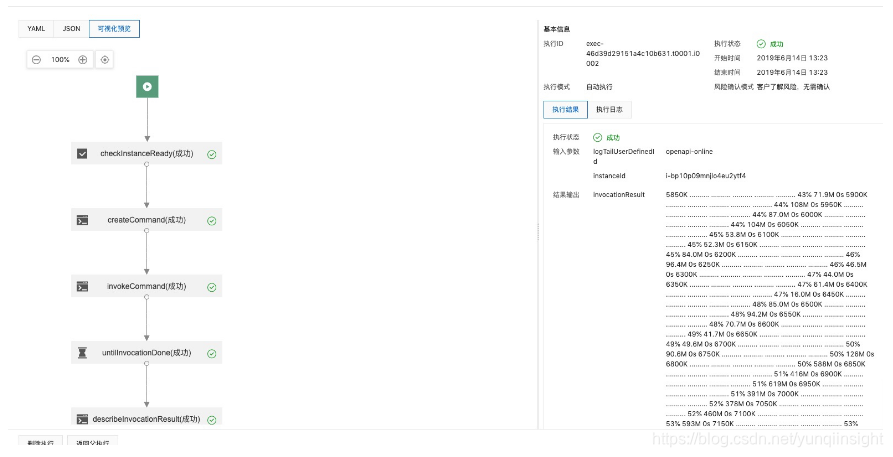场景简介
我们经常会有这样的运维场景,扩容一批机器需要配置SLS日志,对于已经配置好的SLS Logstore后,我们只需要将机器加到机器组里。
解决方案
传统的解决方案是登录每台ecs实例并安装logtail,执行的命令为
wget http://logtail-release-{{ACS::RegionId}}.oss-{{ACS::RegionId}}-internal.aliyuncs.com/linux64/logtail.sh-O logtail.sh; chmod 755 logtail.sh; ./logtail.sh install {{ACS::RegionId}};
echo {{ LogTailUserDefinedId }} > /etc/ilogtail/user_defined_id分解下Task,需要以下几步:
1.检查实例是不是Running状态
2.调用云助手CreateCommand创建上述命令
3.调用InvokeCommand执行
4.等待执行成功
5.删除模板
再转换成OOS模板并创建命名为installSlsAgent
{"FormatVersion": "OOS-2019-06-01","Description": "Install Logtail agent on the ECS Instance.","Parameters": {"InstanceId": {"Type": "String","Description": "the Instance Id to install ilogtail","AllowedPattern": "i-[A-Za-z0-9]*","MinLength": 1,"MaxLength": 30},"LogTailUserDefinedId": {"Type": "String","Description": "the user defined Id write to /etc/ilogtail/user_defined_id","AllowedPattern": "[A-Za-z0-9\\-_]*","MinLength": 1,"MaxLength": 30},"OOSAssumeRole": {"Type": "String","Description": "The RAM role to be assumed by OOS.","Default": "OOSServiceRole"}},"RamRole": "{{OOSAssumeRole}}","Tasks": [{"Name": "checkInstanceReady","Action": "ACS::CheckFor","Description": "describe instances with specified parameters, refer them here: https://help.aliyun.com/document_detail/63440.html","Properties": {"API": "DescribeInstances","Service": "ECS","PropertySelector": "Instances.Instance[].Status","DesiredValues": ["Running"],"Parameters": {"InstanceIds": ["{{ InstanceId }}"]}},"Outputs": {"InstanceIds": {"ValueSelector": "InstanceIdSets.InstanceIdSet[]","Type": "List"}}},{"Name": "createCommand","Action": "ACS::ExecuteApi","Description": "create the command to install logtail agent.","Properties": {"API": "CreateCommand","Service": "ECS","Parameters": {"CommandContent": {"Fn::Base64Encode": "wget http://logtail-release-{{ACS::RegionId}}.oss-{{ACS::RegionId}}-internal.aliyuncs.com/linux64/logtail.sh -O logtail.sh; chmod 755 logtail.sh; ./logtail.sh install {{ACS::RegionId}}; echo {{ LogTailUserDefinedId }} > /etc/ilogtail/user_defined_id"},"Name": "oos-{{ACS::TemplateName}}","Type": "RunShellScript"}},"Outputs": {"CommandId": {"Type": "String","ValueSelector": "CommandId"}}},{"Name": "invokeCommand","Action": "ACS::ExecuteApi","Description": "invoke the command to install ilogtail","Properties": {"Service": "ECS","API": "InvokeCommand","Parameters": {"CommandId": "{{ createCommand.CommandId }}","InstanceIds": ["{{ InstanceId }}"]}},"Outputs": {"InvokeId": {"Type": "String","ValueSelector": "InvokeId"}}},{"Name": "untilInvocationDone","Action": "ACS::WaitFor","Description": "until invocation ready","MaxAttempts": 5,"Properties": {"Service": "ECS","API": "DescribeInvocations","Parameters": {"InvokeId": "{{ invokeCommand.InvokeId }}"},"DesiredValues": ["Finished"],"PropertySelector": "Invocations.Invocation[].InvokeStatus"}},{"Name": "describeInvocationResult","Action": "ACS::ExecuteApi","Description": "get the command invocation result","Properties": {"Service": "Ecs","API": "DescribeInvocationResults","Parameters": {"InvokeId": "{{ invokeCommand.InvokeId }}"}},"Outputs": {"InvocationResult": {"Type": "String","ValueSelector": "Invocation.InvocationResults.InvocationResult[].Output"},"ExitCode": {"Type": "Number","ValueSelector": "Invocation.InvocationResults.InvocationResult[].ExitCode"}}},{"Name": "deleteCommand","Action": "ACS::ExecuteAPI","Description": "clean up the install ilogtail command","Properties": {"Service": "ECS","Risk": "Normal","API": "DeleteCommand","Parameters": {"CommandId": "{{ createCommand.CommandId }}"}}}],"Outputs": {"InvocationResult": {"Type": "String","Value": {"Fn::Base64Decode": "{{ describeInvocationResult.InvocationResult }}"}},"ExitCode": {"Type": "String","Value": "{{ describeInvocationResult.ExitCode }}"}}
}以上模板我们很好的解决了单台机器执行Install sls Agent的任务,那么对于多台机器的执行怎么办呢?OOS的Loop功能可以很好的解决这个问题。并且OOS支持模板嵌套执行,那么我们只需要构建一个传入实例ID列表的
{"FormatVersion": "OOS-2019-06-01","Parameters": {"InstanceIds":{"Type": "List","Description": "the instance id list"},"LogTailUserDefinedId": {"Type": "String","Description": "log tail user defined id","MinLength": 1,"MaxLength": 30}},"Tasks": [{"Properties": {"TemplateName": "installSlsAgent","Parameters": {"InstanceId": "{{ ACS::TaskLoopItem }}","LogTailUserDefinedId": "{{ LogTailUserDefinedId }}"}},"Name": "installSLSAgent","Action": "ACS::Template","Outputs": {"ExitCode": {"ValueSelector": "ExitCode","Type": "Number"}},"Loop": {"Items": "{{ InstanceIds }}","MaxErrors": 100,"Concurrency": 10,"Outputs": {}}}],"Outputs": {}
}创建一个执行

执行后看详细信息,发现执行已经成功并且可以看到每个loop子task的状态

由于子task是一个嵌套执行,我们点击可以看到嵌套的模板执行情况

最后到机器组查看机器状态OK说明已经执行成功

总结
以上我们介绍了如何使用资源编排OOS批量安装SLS-Agent并加入到机器组中,更多场景待挖掘。目前运维编排(OOS)处于内测中,欢迎试用提意见
原文链接
本文为云栖社区原创内容,未经允许不得转载。



















